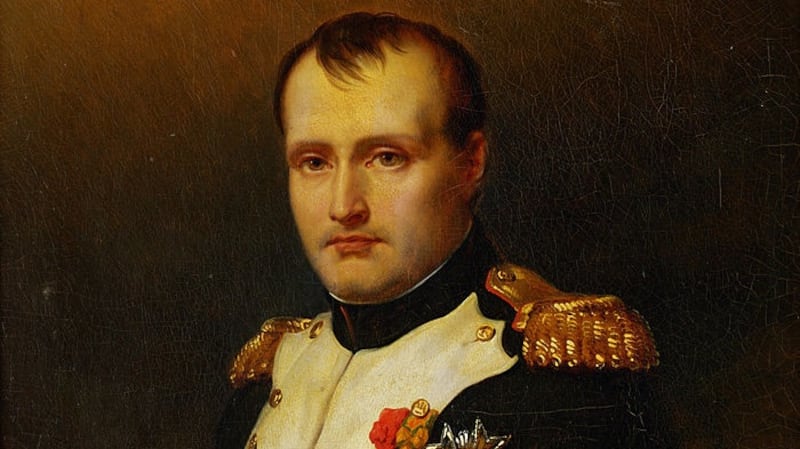It was the arrival late in the day of the Prussian army, after hours of slogging through mud from the east, that finally decided the Battle of Waterloo. But as with all great events, there must have been many other, smaller incidents that helped seal Napoleon’s fate. And in one of the most obvious, as a plaque in Dublin’s Royal Hospital Kilmainham proclaims, an Irishman played the central role.
In a sliding-doors view of history, the "closing of the gate at Hougoumont" may have been the pivotal moment in condemning Bonaparte to his second period of exile, on Saint Helena, where he died 200 years ago today.
The 30 or more French troops who had made it inside were duly slaughtered
Not that the gate was a sliding model. On the contrary, as depicted in painting and sculpture, it was a conventionally hinged affair, so that the struggle to close or open it at one point became a mass push-of-war between the Duke of Wellington’s defenders and the Napoleonic attack.
One of several farms along the front line, Hougoumont's walled enclosure was the focus of desperate fighting throughout the 'day. But a French assault broke through the north gate early in the battle and might have captured this key position had not one James Graham, from Clones, Co Monaghan, succeeded in barring it shut again.
The 30 or more French troops who had made it inside were duly slaughtered (only a drummer boy was spared). Then the gate was reinforced and the position held, albeit with atrocious casualties.
The Duke of Wellington later singled out Hougoumont's defence as an event on which the battle, like the gate itself, swung. He heaped praised on the commanding officer, Scotsman James Macdonnell. But Macdonnell in turn pointed to Graham as hero of the hour.
The Irishman had saved the life of another officer during the chaos and, elsewhere, had to excuse himself from the fighting at one point to rescue his own wounded brother from a burning barn. Sometimes described as "the bravest man in England", Graham survived to live out his days in Ireland, spending his last years as a military pensioner in Kilmainham.
Among the regrets of Napoleon’s remaining life, meanwhile, were that he had not liberated Graham’s homeland from English rule. Or so he confided to another Irishman, Barry O’Meara, who was his physician and friend on St Helena for a time.

But getting back to Hougoumont, the name has gone down in history for reasons other than the Battle of Waterloo. In time it also became synonymous with another part of Irish fighting tradition: those who might have been inclined to side with Napoleon rather than against.
From 1852, for a few years, it was attached to a privately-owned three-masted sailing ship, built in Burma, and used in Britain’s convict-transportation trade.
The voyage itself was unusually well documented, because the Fenian prisoners included several writers
It was then chartered by the French during the Crimean War, although finding the name politically unacceptable, they gave it a new one. But it was again as the Hougoumont that the vessel left England in 1867 for its best-remembered voyage, carrying what proved to be the last consignment of convicts to Australia.
By including 62 Fenians, in fact, the ship was already contravening an agreement with Western Australia barring political prisoners. Their arrival in Fremantle caused consternation.
In the meantime, the voyage itself was unusually well documented, because the Fenian prisoners included several writers. Along with diaries, they produced regular editions of an on-board newspaper: The Wild Goose. It had a modest print run: one copy per issue. But this was read out to passengers and even admiring crew members.
Perhaps the most famous of those involved was John Boyle O’Reilly, then only 23. Sentenced to 20 years of penal servitude, he escaped Australia within 18 months and made his way to the US via several different ships, one of which was due to stop at St Helena, but transferred him to another vessel at sea to forestall his likely arrest.
Thereafter, he became a campaigning journalist in Boston, championing not just Irish freedom but other causes including that of African Americans. Nearly a century later, in the St Patrick's Day address of 1962, President John F Kennedy eulogised him as a champion of the broader civil rights movement and reminded listeners that he "came to Boston by way of a penal colony in Western Australia".
The Hougoumont’s contribution to revolutionary journalism, all seven issues, is today preserved in the state library of New South Wales. The Wild Goose was a playful mixture of poetry, politics, and satire at the expense of Ireland’s then masters. Its floating journalism explains the subtitle, which may or may not also have been a satirical reference to the things that Britannia was traditionally said to rule: “A Collection of Ocean Waifs.”










